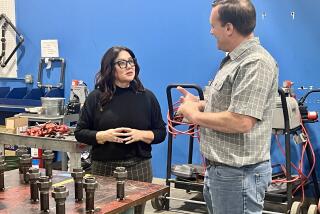‘92 DEMOCRATIC CONVENTION : Labor Has Lot Riding on Clinton Campaign : Democrats: Unions see a do-or-die choice after 12 years of GOP rule. They may play a key role in election.
- Share via
NEW YORK — When the 1968 Democratic National Convention dissolved in shambles over the Vietnam War, organized labor provided the critical strength to help Hubert H. Humphrey clinch the party’s presidential nomination, then propelled him to within an inch of victory in his campaign against Richard M. Nixon.
And Humphrey was the kind of 100% pro-labor candidate that unionists of that day embraced with a special fervor.
Now, despite early differences with presidential nominee Bill Clinton on several issues, organized labor is expected to play an influential role on behalf of the Arkansas governor and expects to support him down to the wire in November.
If anything, their desire for a Democratic takeover of the White House is greater than it was 24 years ago because union leaders believe their organizations face a do-or-die choice after 12 years of conservative Republican administrations.
“Everything’s at stake--the jobs of our members, their health care, everything,” said Leonore Miller, president of the Retail, Wholesale and Department Store Union who is a New York Clinton delegate. “Our people are hurting more than ever.”
For the first time since 1980, the giant Teamsters Union did not endorse a Republican ticket but came out for Clinton during the convention after a well-publicized meeting with the union’s new reform-minded president, Ron Carey.
But, showing a political sophistication about the centrist image that the Clinton forces are trying to project, the union operatives are working mainly behind the scenes at the convention.
More than 1 out of 4 delegates--about 1,000 in all--are carrying a union card at the New York conclave. In large part, they represent a new work force composed primarily of such white-collar occupations as teachers, clerks and health care employees rather than the traditional factory workers and construction trades.
Although the labor presence represents the largest single bloc of delegates, there were only four union leaders among the scores of speakers who addressed the delegates in the weeklong meeting. AFL-CIO President Lane Kirkland even declined an invitation to appear.
“They don’t want to be tagged as the labor candidate and we can go along with that,” said a union spokesman. “But we know we have to carry the water and get the guy elected.”
Dean Tipps, executive secretary-treasurer of the Service Employees’ International Union California Council, put it more bluntly: “We don’t need a lot of stroking--we’re into winning.”
In a display of how the labor movement has changed, Tipps’ union sponsored a Democratic health caucus and printed thousands of signs for a major convention floor demonstration on the theme: “Health Care Our Families Can Afford.”
The Service Employees claim to be the largest union in the health care field, with 300,000 members working in hospitals and clinics. While advancing the union’s interest in a national health insurance program, it also coincided with one of Clinton’s main campaign themes.
“That’s the kind of profile we want,” said Ray Abernathy, a SEIU spokesman.
Even though there were few contested issues at the convention, the AFL-CIO and the National Education Assn. held daily caucuses for their members and established elaborate floor whip systems, complete with telephone beepers.
AFL-CIO officials even watched the proceedings from a sky box, provided by the Democratic National Committee as a convention perquisite. In part, this represents a quid pro quo for organized labor’s considerable financial support for the DNC. A recent report, for example, showed that seven unions contributed a total of $1.3 million to the Democrats’ national headquarters in an 18-month period.
United Steelworkers gave the largest amount--$384,000--while the NEA, Sheet Metal Workers, American Federation of State, County and Municipal Employees, United Auto Workers, American Federation of Teachers and Communications Workers all gave more than $100,000 each to the DNC.
The AFL-CIO’s formal blessing--to be bestowed Sept. 3 on Clinton and his vice presidential running mate, Tennessee Sen. Al Gore--will make available the labor federation’s well-tested political network to the Democratic ticket.
This includes a computerized list of 14 million union members--broken out down to the precinct level--as well as an elaborate system of phone banks and thousands of campaign workers from the ranks of organized labor.
AFL-CIO Secretary-Treasurer Tom Donahue said relations with the Clinton campaign were “very good” and resulted in a platform that met union concerns.
“This is the campaign we have wanted to have for the last 20 years,” Donahue said in an interview. “The economy is in terrible shape and the tendencies to feed greed are so deeply embedded in this Administration that there is no help visible in a Bush second term.”
William Lucy, secretary-treasurer of the AFSCME, put it more bluntly:
“The labor effort will start on Friday (today). We got a good ticket and a good platform and a feeling that, for the first time in a long time, the party is united.”
More to Read
Get the L.A. Times Politics newsletter
Deeply reported insights into legislation, politics and policy from Sacramento, Washington and beyond. In your inbox three times per week.
You may occasionally receive promotional content from the Los Angeles Times.










